Antifreeze Recycling Equipment
Modern antifreeze recycling equipment can turn old worn out coolant into "like new" condition using a process of chemicals and filtration. In todays environmentally conscious society, recycling and the conservation of resources is foremost on most peoples minds. Antifreeze is one of those chemicals that all modern automobiles need to run efficiently and well. With all the focus on gasoline and motor oil, the ethylene glycol in automotive antifreezes is easy to overlook. However, your cars radiator should be flushed and new antifreeze put in at least every 30,000 miles. This makes for a lot of antifreeze that needs to be disposed of properly. There is another solution, instead of replacing your current antifreeze with a new coolant, your old antifreeze can be recycled and used again and again. Nearly all antifreeze is a combination of ethylene glycol and an additive package. Ethylene glycol will not wear out but the additives will become old and useless. This is why antifreeze needs to be replaced. The ethylene glycol, which is the petroleum based component of antifreeze, is still good and useable. Its the additives and the gunk that collects in the your cars coolant that render it unusable.
Antifreeze is one of those chemicals that all modern automobiles need to run efficiently and well. With all the focus on gasoline and motor oil, the ethylene glycol in automotive antifreezes is easy to overlook. However, your cars radiator should be flushed and new antifreeze put in at least every 30,000 miles. This makes for a lot of antifreeze that needs to be disposed of properly. There is another solution, instead of replacing your current antifreeze with a new coolant, your old antifreeze can be recycled and used again and again. Nearly all antifreeze is a combination of ethylene glycol and an additive package. Ethylene glycol will not wear out but the additives will become old and useless. This is why antifreeze needs to be replaced. The ethylene glycol, which is the petroleum based component of antifreeze, is still good and useable. Its the additives and the gunk that collects in the your cars coolant that render it unusable.
How the process works.
Antifreeze recycling equipment will remove the old additives and place new additives into ethylene glycol. The process begins by using a chemical process to separate the old additives from the coolant. (For example, the Viper series produced by Clore Automotive uses the patented Techguard chemicals in this process. )After the chemicals are added to separate the additives from the coolant, the coolant is cycled through the filters to remove any additives, oils and suspended debris that has collected in the antifreeze. There are basically two chemicals that need to be added to the old coolant. The first chemical additive separates the additives from the ethylene glycol and the second chemical additive The second chemical is a coagulant. This will bond the separated additives into particles that can then be captured by the filtration system.
Filtration and removal of the old additives.
Once the antifreeze recycling equipment chemical process has been completed, the coolant will need to run through a filtration system to remove the particles of additives that the coagulant has just created. The Viper 3400 Antifreeze Recycling Equipment by Clore Automotive used three filters to process the treated coolant. The first two filters are a 50 micron and 1 micron rated filter. For example, 1 micron is 1/90th the diameter of a human hair. So not much is getting past a 50 micron rated filter. The third filter in the chain is a carbon filter. The carbon filter will remove any remaining garbage left in the coolant and will even remove the original green dye from it as well.
Creating new antifreeze from the old
Once the ethylene glycol has successfully been separated from the old additives and all the junk has been filtered out, it is time to add in the new additives. This process is not rocket science and it shouldnt scare you off. Just carefully follow the mixing instructions and use the correct chemicals for the antifreeze recycling equipment you are using. Once the new additives are properly mixed in, you will new looking antifreeze complete with green dye. Once the process is completed, the recycled coolant is good for 2 years or 30,000 miles.
Tips for successful antifreeze recycling.
Using antifreeze recycling equipment can be a time consuming process. I would recommend completing the recycling process with the unit away from the vehicle. There is no need to tie up a revenue producing bay with an antifreeze recycling machine connected to a car. Also, remember to follow the manufacturers instruction to the letter to insure the recycled coolant is done correctly. Finally, to extend the life of your filters, carefully monitor the pressure gauge and adjust the machine accordingly.
Jason has been in the construction equipment and industrial sales business for over 10 years. He owns and operates Red Hill Supply to better serve the automotive and industrial industries. - Air Compressors

























